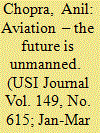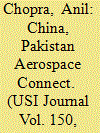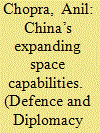| Srl | Item |
| 1 |
ID:
166135


|
|
|
|
|
| Summary/Abstract |
Unmanned aircraft technologies have now matured. The world is at a transition. Dual use (optionally manned) aircraft are flying. Unmanned Combat Air Vehicles (UCAV) are being intensively used in combat with more and more drones being armed with air-to-surface weapons. Unmanned Aerial System (UAS) are taking-off and landing by themselves including on the moving aircraft carrier. Autonomous air refuelling has been tested. Unmanned stealth bombers are under development. Uninhabited helicopter convoys can be used for delivering supplies to troops deployed on combat front lines. Coordinated UAS swarms are already a reality and could also act as a multi strike decoy or jam the enemy defences through sheer numbers. UAS strikes will be a must to lead into territories with integrated air defences. UAS are now mostly being assigned the ‘Dull’, ‘Dirty’ and ‘Dangerous’ missions. UAS are also being used for missions like electronic attack or other non-lethal effects. By the year 2050 every conceivable mission, including heavy lift, would be unmanned. There are ethical and legal issues and also need for regulation. With no pilot inside, there is a risk of lowering the bar to using force. Also there is the risk of terrorists and non-state actors acquiring such assets. A casual hobbyist could by mistake fly a drone into an airliner. All these issues are being considered by regulators. Counter drone technologies are also evolving. India has to accelerate the development of Artificial Intelligence (AI) based weapon systems and platforms to stem excessive technological gap.
|
|
|
|
|
|
|
|
|
|
|
|
|
|
|
|
| 2 |
ID:
172628


|
|
|
|
|
| Summary/Abstract |
The JF-17 Thunder fighter aircraft, jointly developed by Pakistan and China, can be considered a show-case of Sino-Pak defence cooperation. Pakistan continues to be China’s strongest ally. After dismemberment of Pakistan and creation of Bangladesh in 1971, Pakistan forged a formal strategic alliance with China in 1972. The China Pakistan economic Corridor (CPEC) remains the ‘crown-jewel’ of China’s Belt and Road Initiative (BRI). Pakistan continues to be a key element of China’s ‘string of pearls’ policy to create sphere of influence around India. For Pakistan, China is a low-cost-high-value deterrent against India. China helped Pakistan build its military-industrial complex, and Pakistan is the biggest purchaser of Chinese weapons. Aerospace has been the lynch-pin of Sino-Pak defence relationship. China helped Pakistan set up the Pakistan Aeronautical Complex (PAC). Pakistan today produces 25 JF-17 a year, and, with help of China, is looking for export markets in competition with India’s Light Combat Aircraft (LCA). Pakistan Air Force (PAF) and Peoples Liberation Army Air Force (PLAAF) regularly conduct Shaheen series of joint air exercises. Close ties between PLAAF and PAF force Indian Air Force (IAF) to cater for a two front war. Pakistan is strong enough to be a spoiler and, in cahoots with China, could pose a substantial threat.
|
|
|
|
|
|
|
|
|
|
|
|
|
|
|
|
| 3 |
ID:
185820


|
|
|